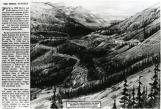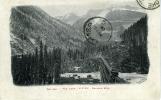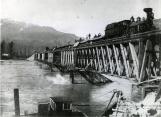1
Canadian Pacific Railway ConstructionUnder the terms of confederation, the government of Canada was committed to building a railway from the Atlantic Ocean to the Pacific Ocean. The Canadian Pacific Railway Company was given the task of completing the railway. Major A.B. Rogers was hired to locate the shortest practicable route through the Selkirks and Rocky Mountains and by 1882 he had surveyed Rogers Pass from both east and west.
2
The steep grades in the mountains made railway construction difficult. In the Kicking Horse, there was a very steep 4.5% grade which was later replaced by the Spiral Tunnels. In Rogers Pass, a series of switchbacks referred to as "The Loops" were constructed. The deep chasms of Surprise Creek, Mountain Creek and Stoney Creek were spanned by spectacular bridges. Mountain Creek bridge was the largest on the whole railway line and contained two million board feet of lumber. The rails of Stoney creek bridge were 92 meters above the creek bed, making it the highest on the continent at that time.4
Spiral Tunnels between Hector and Field.6
The Loop. Canadian Pacific Railway in Selkirk Mountains.7
In the Illecillewaet Valley, 13 bridges across the Illecillewaet river were required. Mud tunnels, even when lined, gave constant trouble and sometimes collapsed. Also the extremely heavy snowfall at that 1200m to 1500m elevation meant a very short working season. In the early fall of 1885, as construction reached Albert Canyon and continued to Second Crossing (of the Columbia River, the location later known as Farwell and, finally, Revelstoke), progress was impeded by incessant rain.8
As the railway progressed West, the large construction camps at Beavermouth, Illecillewaet and Farwell mushroomed into instant towns. As well as general stores, bakeries, barber shops, etc., there were a great number of saloons, dance halls and hostess houses.9
Rogers Pass during railway construction.1885
Rogers Pass, Selkirk Mountains, British Columbia, Canada

10
Rogers Pass settlement during railway construction, 1885.11
Edward Mallandaine, who lives on in Canadian pictorial history as the boy in the photograph of the driving of the Last Spike, came to the construction area in 1885 as a youth of 17 years. He ended up running a "pony express" service between Eagle Pass Landing (Sicamous) and Farwell (Revelstoke).12
Reminiscences of Colonel Edward Mallandaine. 'Camp Life' Read by Jules Thomas.29 June 1940
Eagle Pass, Monashee Range, British Columbia, Canada

13
Reminiscences of Colonel Edward Mallandaine, June 29 1940. 'Camp Life'Read by Jules Thomas.


